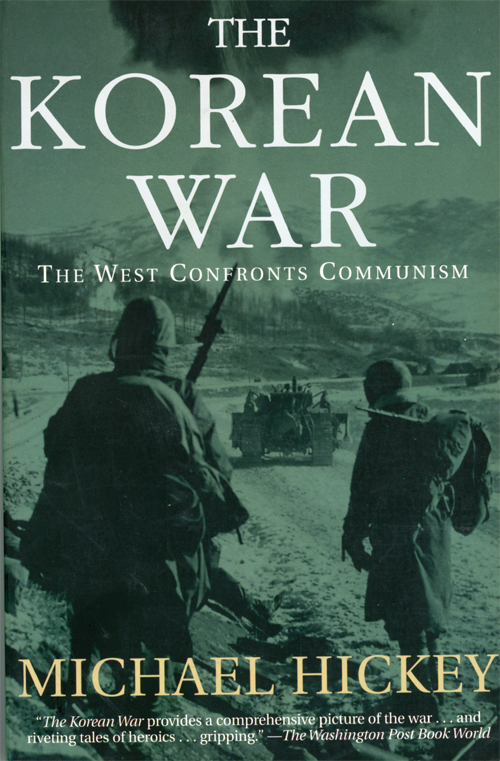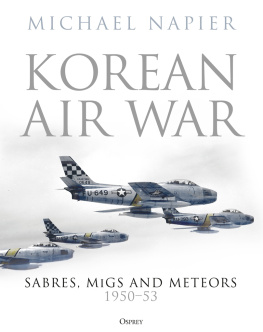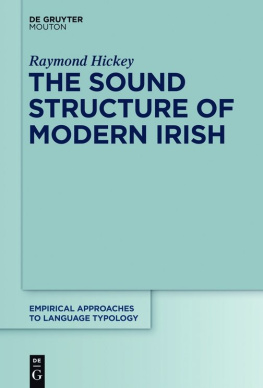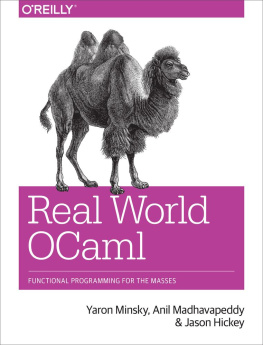Michael Hickey - The Korean War
Here you can read online Michael Hickey - The Korean War full text of the book (entire story) in english for free. Download pdf and epub, get meaning, cover and reviews about this ebook. year: 2012, publisher: The Overlook Press, genre: History. Description of the work, (preface) as well as reviews are available. Best literature library LitArk.com created for fans of good reading and offers a wide selection of genres:
Romance novel
Science fiction
Adventure
Detective
Science
History
Home and family
Prose
Art
Politics
Computer
Non-fiction
Religion
Business
Children
Humor
Choose a favorite category and find really read worthwhile books. Enjoy immersion in the world of imagination, feel the emotions of the characters or learn something new for yourself, make an fascinating discovery.

- Book:The Korean War
- Author:
- Publisher:The Overlook Press
- Genre:
- Year:2012
- Rating:4 / 5
- Favourites:Add to favourites
- Your mark:
- 80
- 1
- 2
- 3
- 4
- 5
The Korean War: summary, description and annotation
We offer to read an annotation, description, summary or preface (depends on what the author of the book "The Korean War" wrote himself). If you haven't found the necessary information about the book — write in the comments, we will try to find it.
The Korean War — read online for free the complete book (whole text) full work
Below is the text of the book, divided by pages. System saving the place of the last page read, allows you to conveniently read the book "The Korean War" online for free, without having to search again every time where you left off. Put a bookmark, and you can go to the page where you finished reading at any time.
Font size:
Interval:
Bookmark:

First published in the United States in 2000 by
The Overlook Press, Peter Mayer Publishers, Inc.
Lewis Hollow Road
Woodstock, NY 12498
www.overlookpress.com
Copyright 1999 by Michael Hickey
All rights reserved. No part of this publication may be reproduced or transmitted in any form or by any means, electronic or mechanical, including photocopy, recording, or any information storage or retrieval system now known or to be invented, without permission in writing from the publisher, except by a reviewer who wishes to quote brief passages in connection with a review written for inclusion in a magazine, newspaper, or broadcast.
ISBN 978-1-46830-557-9
Out of the Sky: A History of Airborne Warfare
The Unforgettable Army: Slim and the 14th Army
Gallipoli
(between pages 78 and 79)
South Korean mounted troops depart for the front, Taegu, August 1950
A round-up of recruits to the Republic of Korea Army
South Korean political prisoners awaiting disposal at Pusan
Communist sympathizers being taken off to execution
A USAF Shooting Star takes off from an airfield in Japan
The landing at Inchon, September 1950
US Marines coming ashore at Inchon, September 1950
US Marines scaling the breakwater, Inchon, September 1950
General MacArthur tours the front, September 1950
An American Patton tank, following the breakout from Pusan
The Australians embark at Kure, Japan
The 56th US Army Port Band welcomes troops ashore
Officers of 27 Commonwealth Brigade confer in the field
General Sir John Harding, C-in-C Far East Land Forces, and Air Vice-Marshal Bouchier at HQ 27 Commonwealth Brigade
Refugees on the road south from Seoul, April 1951
Royal Marines commandos lay a demolition charge
41 Royal Marines commandos prepare covering fire
Men of the 3rd Battalion Royal Australian Regiment on the cold march south, November 1950
The great bug-out: the retreat of the US 2nd Infantry Division, November 1950
Ground crew of the Flying Cheetah squadron de-icing a Mustang
The crew of HMS Charity on the foredeck, winter 1950-1
A Chaffee light tank and crew destroyed near Chipyong-ni, February 1951
US casualties overrun near Chipyong-ni, February 1951
The Australians evacuate their wounded, March 1951
A Vickers machine-gun in action during the battle of Kapyong, April 1951
De-lousing parade: 3rd Battalion Royal Australian Regiment
The 187th US Airborne Division land near Seoul, March 1951
US infantrymen take action to avoid a Chinese communist minefield
(between pages 206 and 207)
General Lawton Collins visits 29 Brigade Group, early 1951
General MacArthur makes his official departure from Japan
A Centurion tank after the battle of the Imjin, April 1951
Inspecting landmine damage to an armoured car, summer 1951
A Chinese Peoples Army leaflet invites UN troops to surrender
A marshalling yard in North Korea attacked by USAF light bombers
F-86 Sabre fighters of the 5th US Air Force at dispersal
The capture of Hill 355 (Little Gibraltar)
The 2nd Regiment, Royal Canadian Horse Artillery, in action, north of the Imjin
A Chinese prisoner receiving treatment at the Norwegian MASH
US Army helicopters evacuating casualties from the Indian Field Ambulance
Life Saver. The 8225th Mobile Army Surgical Hospital, Korea, 1951
The light fleet carrier HMS Ocean en route to Korea
A Sea Fury crash-lands on the deck of HMS Ocean
Bridge-building on the Pukhan river, November 1951
78 Company RASC transports the Australians across a US pontoon bridge
A meeting of senior officers in the field, April 1952
The American 8-inch gun, The Persuader
An airstrike near the Hook
Defence positions on the Hook after bombardment by the Chinese
The author relaxing on the road from Seoul to Pusan, October 1951
The 60th Indian Parachute Field Ambulance near Suwon, spring 1951
A gun crew of the US Army artillery prepare to carry out a fire mission
Winter billets
General Lawton Collins with other senior officers on a visit to 1st Commonwealth Division, July 1952
RAF engine fitters at work in the field
North Korean prisoners of war at work on Koje Island
The Glosters being debriefed following Little Switch
The author and publishers wish to thank the following for permission to reproduce illustrations: Plates 1, 2, 3, 4, 6, 7, 19 and 56, Hulton Getty; 5, US Air Force; 8, 9, 27, 40, 43 and 46, US Army Military History Institute; 10 and 38, the late Revd Lorentz Pedersen; 11, 13, 18, 24 and 26, Australian War Memorial (Accession Nos. PO1813.576, PO1813.659, PO1813.865, PO1813.745, PO2201.125); 12, 45, 52 and 54, Museum of Army Flying, Middle Wallop; 14, 20, 21, 29, 30, 32, 34, 41, 42, 48, 50, 53 and 55, Imperial War Museum; 15, 22, 23, 25, 35 and 39, Lieutenant-Colonel Alf Argent; 16 and 17, Mr A.E. Hales; 28, US Army; 36, Lieutenant-Colonel Barney Henderson; 47, Colonel M. Farmer; 51, US Signal Corps. Plates 31, 33, 37, 44 (crown copyright) and 49 are from the authors collection.
C ommanding an RASC transport platoon as a newly commissioned Second Lieutenant I was an insignificant packhorse in the Korean War. Like my contemporaries I was ignorant of the higher strategy and politics that had brought us there. Our main preoccupation was survival through that first terrible winter of the war; great events such as the sacking of General MacArthur, our commander-in-chief, passed almost unnoticed, whilst few of us spared a charitable thought for that God-forsaken country and its unfortunate people. For young men who had never left the shores of the United Kingdom, Korea in 1950 came as a dreadful shock: a nation assaulted and raped, deprived of its very identity by forty years of Japanese occupation, now shattered by invasion from the north. Filthy, malodorous, its population reduced to beggary and totally demoralized, it presented an unlovely picture.
All those of us sent from Britain to Korea in 1950 were painfully aware of the parlous state of the British economy, and particularly of the armed forces; looking back over half a century it is astonishing that, from an army of several hundred thousand officers and men, it proved so difficult to assemble and equip a brigade to go to the other side of the world without resort to a call-up of reservists. Much of the forces equipment was of 193945 vintage, a lot of it much older. During that first winter we had to live mostly in the open in appalling weather conditions with inadequate winter clothing and tentage. Despite this, the performance of British and Commonwealth troops, sailors and airmen was in the highest traditions of their services. The youngest national servicemen who served there so admirably are now old age pensioners and it is hard to realize that all this happened nearly fifty years ago the same gap as separated us in 1950 from the Boer War. This account aims to show something of the British and Commonwealth contribution to that campaign, in relation to the far greater undertaking of the Americans and South Koreans. Its aim will have been achieved if the reader emerges at the end with a sense of what it was like to serve in MacArthurs curious Tokyo headquarters, shiver in a frozen slit trench, swelter in the baleful humidity of a Korean summer, endure captivity, fly combat missions in bombers and jet fighters against formidable opposition, fight the treacherous tides of Korean coastal waters under the fire of hostile batteries, or march over the northern mountains in the depth of winter with the Marines.
Font size:
Interval:
Bookmark:
Similar books «The Korean War»
Look at similar books to The Korean War. We have selected literature similar in name and meaning in the hope of providing readers with more options to find new, interesting, not yet read works.
Discussion, reviews of the book The Korean War and just readers' own opinions. Leave your comments, write what you think about the work, its meaning or the main characters. Specify what exactly you liked and what you didn't like, and why you think so.











